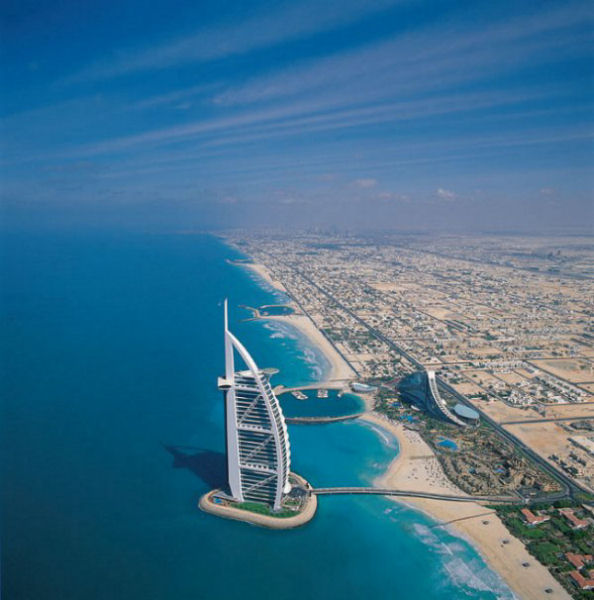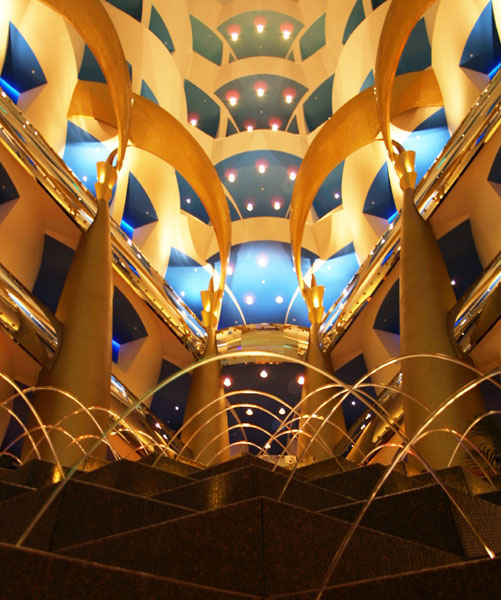The Burj Al Arab (Arabic: برج العرب,"Arab Tower", also known as "Arab Sail") is a seven-star hotel located in Dubai, United Arab Emirates. At 321 m (1,053 ft), it is the fourth tallest hotel in the world. The Burj Al Arab stands on an artificial island 280 m (920 ft) out from Jumeirah beach, and is connected to the mainland by a private curving bridge. It is an iconic structure whose shape mimics the sail of a ship.
The beachfront area where the Burj Al Arab and Jumeirah Beach Hotel are located was previously called Chicago Beach. The hotel is located on an island of reclaimed land offshore of the beach of the former Chicago Beach Hotel. The locale's name had its origins in the Chicago Bridge & Iron Company which at one time welded giant floating oil storage tankers on the site.
The old name persisted after the old Hotel was demolished in 1997. Dubai Chicago Beach Hotel remained as the Public Project Name for the construction phase of the Burj Al Arab Hotel until Sheikh Mohammed bin Rashid Al Maktoum announced the new name.
Construction of Burj Al Arab began in 1994. It was built to resemble the sail of a dhow, a type of Arabian vessel. Two "wings" spread in a V to form a vast "mast", while the space between them is enclosed in a massive atrium. The architect Tom Wright[5] said "The client wanted a building that would become an iconic or symbolic statement for Dubai; this is very similar to Sydney with its Opera House, or Paris with the Eiffel Tower. It needed to be a building that would become synonymous with the name of the country."
The architect and engineering consultant for the project was Atkins, the United Kingdom's largest multidisciplinary consultancy. The hotel was built by South African construction contractor Murray & Roberts.
Several features of the hotel required complex engineering feats to achieve. The hotel rests on an artificial island constructed 280 m (920 ft) offshore. To secure a foundation, the builders drove 230 forty-metre (130 ft) long concrete piles into the sand.
Engineers created a surface layer of large rocks, which is circled with a concrete honeycomb pattern, which serves to protect the foundation from erosion. It took three years to reclaim the land from the sea, while it took fewer than three years to construct the building itself. The building contains over 70,000 m3 (92,000 cu yd) of concrete and 9,000 tons of steel.
Inside the building, the atrium is 180 m (590 ft) tall.
Burj Al Arab is the world's second tallest hotel (not including buildings with mixed use). The structure of the Ryugyong Hotel in Pyongyang North Korea, is 9 m (30 ft) taller than the Burj Al Arab.
The hotel is managed by the Jumeirah Group. Despite its size, the Burj Al Arab holds only 28 double-storey floors which accommodate 202 bedroom suites. The smallest suite occupies an area of 169 m2 (1,820 sq ft), the largest covers 780 m2 (8,400 sq ft).[9]
Suites feature design details that juxtapose east and west. White columns show great influence. Bathrooms are accented by mosaic tile patterns.
One of its restaurants, Al Muntaha (Arabic for "Highest" or "Ultimate"), is located 200 m (660 ft) above the Persian Gulf, offering a view of Dubai. It is supported by a full cantilever that extends 27 m (89 ft) from either side of the mast, and is accessed to a panoramic elevator. The main chef there, Edah Semaj Leachim, was awarded Chef of the Year 2006 and also owns the restaurant, in accordance with the Burj Al Arab hotel.[citation needed]
Another restaurant, the Al Mahara ("Oyster"), which is accessed via a simulated submarine voyage, features a large seawater aquarium, holding roughly 990,000 litres (35,000 cu ft) of water. The tank, made of acrylic glass in order to withstand the water pressure, is about 18 cm (7.1 in) thick.
The Burj Al Arab has attracted criticism as well as praise, described as "a contradiction of sorts, considering how well-designed and impressive the construction ultimately proves to be." The contradiction here seems to be related to the hotel’s decor. "This extraordinary investment in state-of-the-art construction technology stretches the limits of the ambitious urban imagination in an exercise that is largely due to the power of excessive wealth." Another critic includes negative critiques for the city of Dubai as well: "both the hotel and the city, after all, are monuments to the triumph of money over practicality. Both elevate style over substance." Yet another: "Emulating the quality of palatial interiors, in an expression of wealth for the mainstream, a theater of opulence is created in Burj Al Arab … The result is a baroque effect"







No comments:
Post a Comment